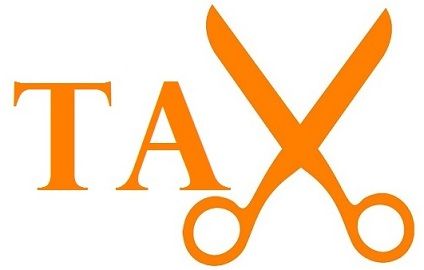 Taxes charged directly on the income or wealth of an individual is called Direct Tax. On the contrary, an indirect tax is a tax that is added to the price of goods and services.
Taxes charged directly on the income or wealth of an individual is called Direct Tax. On the contrary, an indirect tax is a tax that is added to the price of goods and services.
What is a Tax?
Tax is a financial obligation, payable to the government for the cost of living in a society. It is a fee levied by the government of the respective country or territory on income, activities, goods, and services. It is broadly classified into direct tax and indirect tax.
Why Tax is imposed?
The main reason for imposing taxes is that they are the main source of government revenue. Revenue collected by the government is used for the purpose of providing public utility services like defense, education, infrastructure facilities, health care, etc. So, we can say that government imposes taxes to fulfill the socio-economic objective.
In this post, we will talk about the difference between direct tax and indirect tax.
Content: Direct tax Vs Indirect Tax
- Comparison Chart
- Definition
- Key Differences
- Video
- Taxes Levied by Various Authorities
- Types
- Advantages and Disadvantages
- Conclusion
Comparison Chart
| Basis for Comparison | Direct Tax | Indirect Tax |
|---|---|---|
| Meaning | Direct tax refers to financial charge, levied directly on the taxpayer, and paid outrightly to the authority which imposes it, by the taxpayer. | Indirect tax is when the taxpayer is just the hands that deposit the amount of tax to the authority imposing it, while the burden of tax falls on the final consumer. |
| Governed by | Central Board of Direct Taxes (CBDT) | Central Board of Indirect Taxes and Customs (CBIC) |
| Who pays the tax? | Individuals, HUF, and Companies | Final Consumer |
| Nature | Progressive | Regressive |
| Incidence and Impact | It falls on the same person. | It falls on different persons. |
| Liability | A person on whom the tax is imposed is liable for its payment. | The person receiving the benefits is liable for its payment and not the person on whom it is imposed. |
| Evasion | Tax evasion is possible. | Tax evasion is hardly possible because it is included in the price of the goods and services. |
| Inflation | Direct tax helps in reducing inflation. | Indirect taxes promotes inflation. |
| Imposition and collection | Imposed on and collected from assessees, i.e. Individual, HUF (Hindu Undivided Family), Company, Firm, etc. | Imposed on and collected from consumers of goods and services but paid and deposited by the assessee. |
| Burden | Cannot be shifted to another person. | Can be shifted to another person. |
| Taxable Event | When the income or wealth of the assessee reaches the maximum limit. | Purchase, sale or manufacture of goods and provision of services. |
| Collection of Tax | Difficult | Easy |
Definition of Direct Tax
Direct tax is that kind of tax, whose flow is direct, from the taxpayer to the Government. When the liability of tax falls on the same person who has to make payment of it, then the tax is said to be direct. That is to say, the individual on whom tax is levied, also bears the burden of it, in case of a direct tax. Thus such taxes cannot be shifted to another person.
- Direct Taxes are the primary source of government revenue.
- It is progressive in nature i.e. it increases with an increase in income or wealth and vice versa.
- It operates on the notion of the ability to pay.
Meaning that it levies according to the paying capacity of a person. And so, the ones who earn more, pay more. In this way, the tax liability on the rich is more in comparison to the poor.
Also Read: Difference Between ITR-1 and ITR-4s
Definition of Indirect Tax
Indirect tax is one whose flow is not direct, i.e. implied, as it flows through others. When the taxpayer is the hands that deposit tax to the authorities, and at each stage, the incidence keeps on shifting until it reaches the ultimate consumer, who actually bears its burden, it is called an indirect tax.
Here, one should note that indirect taxes are not paid by the assessee directly to the government, rather it is imposed on goods and services, which is collected by the intermediaries on behalf of the government and then deposited by them.
These taxes are levied on the price of goods and services when they are produced and sold. So, it is the consumers who consume the product and bears the incidence at the end, but the immediate liability for the payment of tax falls upon the intermediary, i.e. manufacturer or retailer.
As it is not based on the principle of ability to pay, it is regressive in nature, as the burden of tax is borne by each class of people equally.
Do You know?
Previously, there are various indirect taxes that were imposed in India like excise duty, customs duty, service tax, sales tax, entertainment tax, purchase tax, luxury tax, etc. However, with the emergence of the Goods and Services Tax (GST), many indirect taxes were amalgamated into one. And only customs duty continues to levy even after the introduction of GST.
Stages of Imposition of Indirect Taxes
- Stage 1 – Levy: Those liable for tax are identified and charged.
- Stage 2 – Assessment: Process adopted for the ascertainment of indirect tax liability.
- Stage 3 – Collection: Tax collected by the Revenue department from the assessee.
Also Read: Difference Between Progressive Tax and Regressive Tax
Key Differences Between Direct Tax and Indirect Tax
As of now, we have discussed the basics of the two types of taxes, now we will move forward to understand the difference between direct tax and indirect tax:
- Direct Tax refers to the tax which is paid directly to the government by the person on whom it is imposed. On the other hand, Indirect tax is a form of tax that is paid by the taxpayer to the government, but the amount of tax is recovered from another person, who gets the benefits, i.e. the final consumer.
- The Central Board of Direct Taxes (CBDT) functioning under the Department of Revenue is the authority that administers Direct Taxes in India. Conversely, the Central Board of Indirect Taxes and Customs (CBIC) is the authority responsible for the administration of Indirect Taxes.
- While Direct tax is levied on the assessee, which may include Individual, HUF, Company, AOP, BOI, etc. Indirect Tax is paid by the final consumer.
- Direct Tax is progressive in nature, as it is based on the percept of ability to pay. So, the tax is imposed more on the rich and less on the poor. Oppositely, Indirect Tax is regressive in nature, as every person contributes equally to the payment of taxes.
- Direct Tax is one in which the incidence and impact of the tax fall on the same person, whereas Indirect tax is a tax in which the incidence and impact of the tax fall on different persons. Here incidence refers to the liability for the payment of tax, and impact means actual payment of tax.
- In the case of a direct tax, it is the taxpayer who bears its burden, i.e. it cannot be shifted to or recovered from another person. Conversely, in indirect taxes, the burden of tax can be shifted to another person.
- Direct taxes are when the assessee on whom the tax is imposed, is liable for its payment. Contrastingly, indirect taxes is when the person receiving the benefits is liable for its payment and not the person on whom it is imposed.
- Tax evasion is a practice of deliberately avoiding the payment of taxes while taking recourse to unlawful means. In the case of direct taxes, tax evasion is possible, whereas, in the case of indirect taxes, tax evasion is not possible as the amount of tax is hidden in the price of the goods and services itself.
- While direct taxes help in controlling inflation, by absorbing excess liquidity from the market, indirect taxes give rise to inflation or deflation.
- Direct taxes are imposed on and collected from assessees, which includes individuals, HUF, companies, etc. whereas indirect taxes are imposed on and collected from consumers of goods and services but paid and deposited by the assessee to the government.
- Direct tax is charged on individuals, HUF, and business entities, and the burden cannot be shifted to others. As against, Indirect tax is charged on commodities and services, and its burden can be shifted to others.
- The taxable event in the case of direct tax, when the income of the assessee reaches the maximum limit specified under the law, the exceeding amount will become taxable. Contrarily, whenever there is a purchase/sale/manufacture of goods and provision of services, it is a taxable event in the case of indirect taxes.
- Talking about administrative cost, the administrative cost of direct tax is greater in comparison to indirect taxes.
Video: Direct Vs Indirect Tax
Types of Direct Tax
The different types of direct taxes are: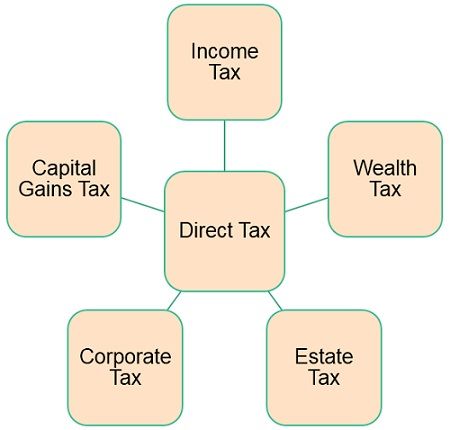
Income Tax:
The tax imposed on the income earned by an assessee is called Income Tax. The rate of tax depends on the age and total earning during the previous year. For this purpose, the government introduced different tax slabs, and on the basis of those slabs, one can calculate the amount of tax he/she has to pay in the assessment year. And to do so, the assessee has to file Income Tax Return (ITR) for the concerned year.
Also Read: Difference Between Previous Year and Assessment Year
Wealth Tax:
Tax on the wealth of the assessee, determined by the property he/she owns and the market value of that property. The tax is paid annually, irrespective of the fact that if the property generates income for the individual or not.
Estate Tax:
Otherwise called inheritance tax, the tax has to be paid on the estate or money that a person has left for his/her family after he passed away.
Corporate Tax:
Domestic Companies and Foreign Companies (who earn income in India) are required to pay Corporate Tax. Further, it includes Securities Transaction Tax (STT), Dividend Distribution Tax (DDT), Fringe Benefits Tax, Minimum Alternate Tax (MAT), etc.
Capital Gains Tax:
Tax to be paid on the income earned on the sale of capital assets and investments. On the basis of the holding period, it is divided into – long-term and short term capital gain.
Also Read: Difference Between Short Term and Long Term Capital Gain
Types of Indirect Tax
There are several types of indirect taxes, which are discussed hereunder: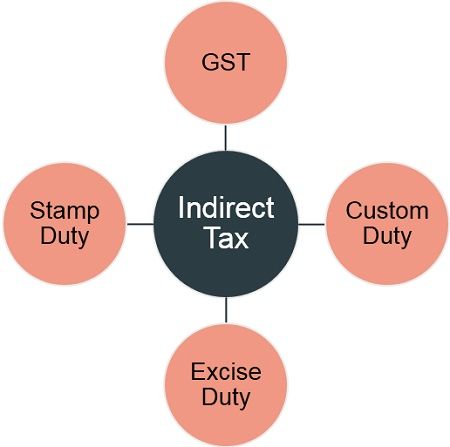
Goods and Services Tax (GST):
As the name suggests, GST is a single tax imposed on the supply of goods and services. Further, under the GST regime goods and services are treated equally for the purpose of imposition of taxes. The aim is to subsume various indirect taxes, imposed by Central and State Governments.
Also Read: Difference Between VAT and Service Tax
Customs Duty:
Customs Duty is imposed on the imports and exports of goods, at a specified rate. It is levied with an aim of reducing illegal import and export of goods.
Excise Duty:
Duty charged by the government on the production of certain items is called Excise Duty. The liability for the payment of such duty is on the manufacturer of the goods, which is then recovered from the final consumer.
Stamp Duty:
Duty to be paid on the transfer of immovable property within the state is called stamp duty. The duty is charged by the government in whose jurisdiction the property is located.
Also Read: Difference Between Tax and Duty
Taxes Levied by Various Authorities in India
| Authority | Direct Tax | Indirect Tax |
|---|---|---|
| Central or Union Government | Income Tax (not including agricultural income) | Central Goods and Services Tax (CGST) |
| Central Sales Tax | ||
| Excise Duty on Petroleum Products | ||
| Customs Duty | ||
| State Government or Union Territory | Tax on Agriculatural Income | State Goods and Services Tax (SGST)/Union territory Goods and Services Tax (UTGST) |
| Professional Tax | Excise Duty on Liquor | |
| Local Authority | Municipal Tax on Property, Water Tax, etc | Entry Tax |
Advantages and Disadvantages of Direct Tax
Advantages
- Equity: Direct Taxes are based on the Principle of Ability to Pay and hence it promotes equity of sacrifice on the basis of the volume of income earned by a person during a financial year. Therefore, the rate of tax increases with an increase in the level of income.
- Certainty: As the tax, the slab is determined every year during the budget. It brings awareness to the assessee regarding the quantity of tax to be paid, rate of tax, time of payment, mode of payment, the penalty for non-payment, and so forth.
- Reduces income inequality: As the tax is progressive in nature, so the tax is collected more from the rich and less from the poor people, which tends to reduce income inequality.
- Controls Inflation: Direct taxes act as a tool to curb inflation, by absorbing excess money in circulation, increasing the tax rate, imposing new taxes, etc.
- Relatively Elastic: Direct taxes increase with the increase in income and wealth, which makes it relatively elastic.
Disadvantages
- Tax evasion: Direct tax is a lump sum payment, made to the government by the assessee, so the taxpayer attempts to evade taxes, using various unlawful means.
- Uneconomical: A huge amount is spent on the collection of direct taxes, as it requires a large workforce for its collection and administration.
- Arbitrary: Due to the absence of any scientific principle or logic, in the determination of the degree of progression in the taxes, these taxes are arbitrary in nature.
- Feels like a burden: As a huge amount has to be paid by the assessees in connection to tax, so they treat it as a burden. Also, the documentation process itself is very long and consumes time.
Also Read: Difference Between Tax Avoidance and Tax Evasion
Advantages and Disadvantages of Indirect Tax
Advantages
- Major source of revenue: As indirect taxes are imposed on the price of goods and services, which include both necessities and luxuries, consumed by a large group of people around the country. So, they contribute to the generation of revenue.
- No Possibility of Tax Evasion: As the tax is added to the price of the goods and services, tax evasion is not possible.
- Convenience: As the taxes are hidden in the price of the commodity and usually of small amount, it becomes easy for the people to pay taxes, as the burden is not felt.
- Economical: Due to the easy and simplified procedure of the collection of these taxes, the cost of collection and administration cost is quite low.
- Wide coverage: Almost all the goods and services are covered under the indirect tax regime. Further, all the individuals around the country, equally contribute to the payment of these taxes. Hence, both haves and have nots contribute to the development of the country.
- Variable Rates: The rate of tax is high for harmful products as compared to the other goods which are necessary for life.
Disadvantages
- Regressive: As there is no distinction between rich and poor, the burden of the tax falls on each category equally, making it a regressive tax, which avoids the principle of ability to pay.
- Increases the price of goods and services: As the amount of tax is included in the price of goods and services, it makes them expensive.
- Lack of awareness in consumers: As the price of the commodity includes the amount of tax, many consumers are unaware of the fact that they are paying tax. Hence, it is easier to extract from the general public.
Also Read: Difference Between Tax Credit and Tax Deduction
Conclusion
The imposition of taxes is important for the collective welfare of the society and a means for economic development. A good taxation system possesses the following characteristics – equity, certainty, convenience, redistribution, flexibility, encourage investments, etc.
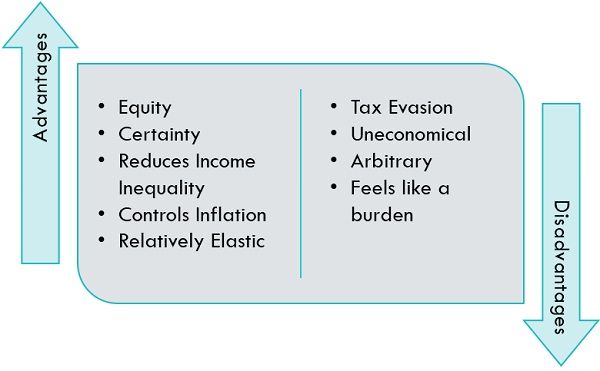
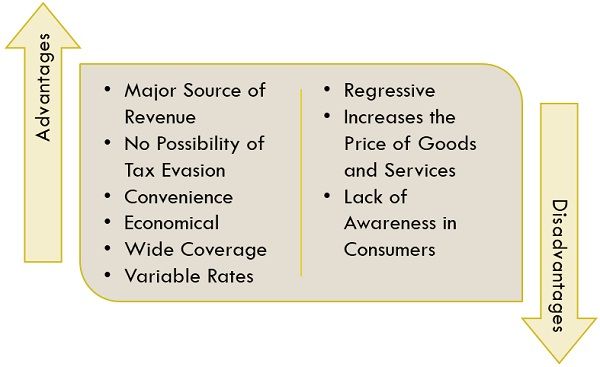






DEBYENDU PANJA says
It is very useful to us.. and please provide me difference between agricultural income and non agricultural income.
Surbhi S says
Thanks for your appreciation and we will consider your suggestion.
rajesh says
good comparision but can you proved how direct is progressinve and reduce inflation and similarly for indirect taxes being regressinve and promotes inflation
Surbhi S says
The progressive tax is a tax wherein the tax rate increases as the income of the taxpayer increases while the regressive tax is a system of taxation where the rate of tax decreases with the increase of taxable amount. In this way, direct tax cub inflation but indirect tax promotes the same.
kuldeep says
Great Article! i visit the page and i find this article much valuable and useful. Thank you for sharing.
sandamali amarasingha says
a good effort.. thank you guys.added lot of knowledge.
kartik thakur says
Thanks.
Bandana says
Very useful and clear distinction which I needed . Thank you so much
VJK Sarravanan says
Superb Ma’am
Shubham says
God bless!
Bijayalaxmi says
It’s very useful and easy to understand…
Thank you so much!!
Quickbooks error code 3371 says
You really explained this article very well. I really appreciate your writing skills. Keep up the good work.
Francis says
Since taxation is paid for the government, does it matter if the tax is direct or indirect
Sneha Rout says
It is very clearly defined. Helps a lot to gain information and to clear doubts.
Thank You for spreading knowledge to the world.